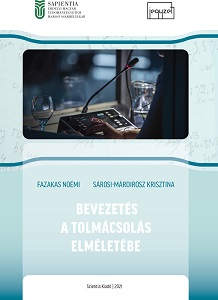Bevezetés a tolmácsolás elméletébe
Introduction into the Theory of Interpreting
Author(s): Noémi Fazakas, Krisztina Sárosi-Márdirosz
Subject(s): Language and Literature Studies, Translation Studies
Published by: Scientia Kiadó
Keywords: theory of interpreting; court interpreting; community interpreting; remote interpreting; media interpreting; interpreter;
Summary/Abstract: The aim of this university course book is to serve as an introduction into the theory of interpreting for second-year students of translation and interpreting, although the chapters also cover practical insights on specific topics due to the nature of the field. The first part focuses on the profession (Interpreting studies), while the second one on the interpreter as a person (Interpreter studies). The chapters present the most important types of interpreting (court interpreting, community interpreting), nevertheless, we also explore the characteristics of interpreting in the European Union institutions, the basic aspects of evaluating interpreters, issues of remote interpreting and media interpreting. In the second part, which focuses on the interpreter as a person, psychological cognitive aspects are discussed, and the personality traits of interpreters are also presented. The chapters of the second part discuss the topic of information processing and memory, the relationship between creativity and interpreting, the issue of stress in the lives of interpreters and the concept of quality assurance in relation to interpreting. The course book aims to convey theoretical knowledge using the international scholarly literature, including the most important results of the research carried out by Hungarian specialists, but at the same time it wants to shed light on certain aspects of the profession from the perspective of the characteristics of the Romanian translation and interpreting market. Although the course book seeks to discuss theoretical issues related to the profession and the teaching of the profession, the emphasis shifts in many respects to practical problems that also prepare students to practice interpreting as a profession. In this way, the authors want to ensure that students enrolled in the Translation and interpreting programme not only know their future profession from a theoretical point of view, but also its practical aspects, difficulties and inherent professional and financial opportunities, and that they find their place on the market after completing their undergraduate studies. The literature is thus listed in the bibliography at the end of each chapter, with the aim of making it easier for students to review the Hungarian and international literature on a particular aspect of interpretation.
Series: Jegyzetek
- Page Count: 244
- Publication Year: 2021
- Language: Hungarian
- eBook-PDF
- Table of Content
- Introduction

